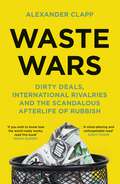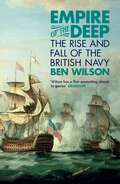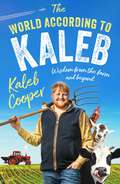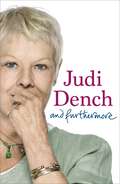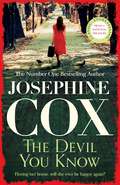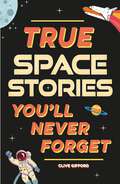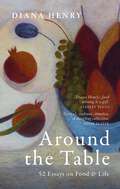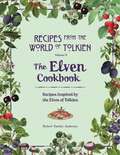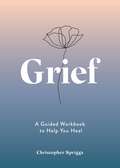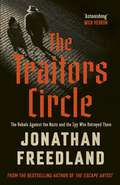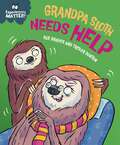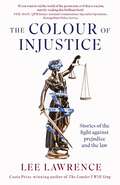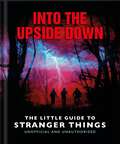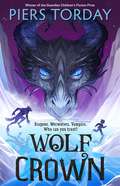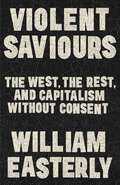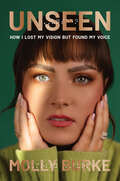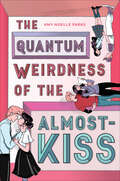- Table View
- List View
Shattered Moonlight: The scorching romantasy sequel you were waiting for! (The Moonlight Series #2)
by K.C. HarperWelcome to the spicy sequel of Shadowed Moonlight, the urban romantasy series filled with witches and werewolves.Kane and Briar are back . . . but so is the danger.Briar and Kane have solved Cambria's murder, but the trouble keeps coming: Briar's stepfather was the one pulling their strings all along. Now he's compelling her to protect his secrets while he uses her as a pawn in his torturous game.Torn between her stepfather's commands and her own heart, Briar struggles with her new role as her coven's second. And with Kane as Alpha of the Northern Pack, duty threatens to rip them apart.Then Kane's old flame reappears, igniting Briar's jealousy and throwing another wrench into their suddenly complicated relationship.With secrets, suspicions, and powerful forces working to tear them apart, can Kane and Briar weather this storm?READERS LOVE IT'An unforgettable urban romantasy' ⭐⭐⭐⭐⭐'A compelling blend of mystery and romance' ⭐⭐⭐⭐⭐'This book had me on my KNEES' ⭐⭐⭐⭐⭐'The romance was incredible had me audibly squealing' ⭐⭐⭐⭐⭐'A gritty urban fantasy that will sink its claws into you from page one' ⭐⭐⭐⭐⭐
Waste Wars: Dirty Deals, International Rivalries and the Scandalous Afterlife of Rubbish
by Alexander Clapp'Jaw-dropping' The Economist'A mind-altering and unforgettable read' Adam Tooze'If you wish to know how the world really works, read this book' Misha GlennyA globe-trotting investigation into the catastrophic reality of the multi-billion-dollar global garbage trade.Dumps and landfills around the world are overflowing. The millions of tonnes of garbage generated every day have given rise to waste wars, cons and cover ups across thousands of miles and multiple oceans. And few people have any idea they're happening.Roaming across five continents, Alexander Clapp delves deep inside the world of Javanese recycling gangsters, cruise ship dismantlers in the Aegean, Tanzanian plastic pickers, whistle-blowing environmentalists in the jungles of Guatemala, and a community of Ghanaian boys who burn Western cellphones and televisions for cents an hour. He reveals how most of our trash actually lives a secret second life, getting shipped, smuggled or dumped from one country onto another, with devastating consequences for the poorest nations of the world.Waste Wars is a jaw-dropping exposé of how and why, for the last forty years, our garbage has spawned a massive global black market, one that offloads our consumption footprints onto distant continents, pristine landscapes, and unsuspecting populations.
What is Wrong with the World?: The Surprising, Hopeful Answer to the Question We Cannot Avoid
by Timothy Keller'Phenomenally insightful' (Goodreads review)⭐⭐⭐⭐⭐What Is Wrong with the World? is not a list of answers - it's an invitation to tell the truth. About what hurts. About what we're still carrying. It's for anyone ready to stop performing and start healing.Beloved pastor and New York Timesbestselling author Timothy Keller offers a hope-filled answer to the question beneath every devastating headline and personal loss: What is wrong with the world?Everywhere we look, we see brokenness - wars, cruelty, and heartache. We feel it in the world around us and in our own lives. How did it get to be this way?In What Is Wrong with the World?, based on a series of teachings given at Redeemer, Keller argues that the only thing that can account for the world's pain and chaos is what the Bible calls sin. What Is Wrong with the World?is for anyone who:Feels overwhelmed at the state of the world;Battles with repeated mistakes and poor choices;Desires more than pat answers to difficult questions;Wonders how to know joy while still acknowledging pain; Wants to understand how God's love gives hope even in the hardest of places.This hugely hopeful book reveals how sin is not simply a "bad" thing we do but something much more subtle and complex, affecting our relationships, our thinking, and every aspect of our existence. And once we recognise sin for what it is, can we find the profound, life-transforming answers our souls long for.
Empire of the Deep: The Rise and Fall of the British Navy
by Ben WilsonThe bestselling complete history of the British Navy - our national story through a different prism.The story of our navy is nothing less than the story of Britain, our culture and our empire. Much more than a parade of admirals and their battles, this is the story of how an insignificant island nation conquered the world's oceans to become its greatest trading empire. Yet, as Ben Wilson shows, there was nothing inevitable about this rise to maritime domination, nor was it ever an easy path. EMPIRE OF THE DEEP: THE RISE AND FALL OF THE BRITISH NAVY also reveals how our naval history has shaped us in more subtle and surprising ways - our language, culture, politics and national character all owe a great debt to this conquest of the seas. This is a gripping, fresh take on our national story.
How to Awaken Your Inner Goddess: Empowering Rituals and Affirmations to Help You Radiate Divine Feminine Energy
by Sally BrockwayStep into your divine power and become the magnetic woman you were always meant to beYou are a goddess. Within you is a sacred energy that holds the key to irresistible confidence, deep self-knowledge and enriched well-being. From the sensual creativity of the dark feminine to the empathetic grace of the light feminine, the divine feminine is a rich and varied identity through which any woman can find meaning, empowerment and healing. Whether your goal is to heighten your intuition, supercharge your self-esteem, or develop high vibrational habits and behaviours to attract the things you desire, this beautiful book will guide you on your journey to transforming your relationship with yourself. As well as affirmations, rituals for self-love and tips on how to awaken and channel your feminine energy, within this book you will also discover:- A host of benefits that come with embracing the divine feminine- Which feminine archetype you embody and how this manifests in your life- How to identify and remove any blocks in your feminine energy to become your most authentic selfLet your inner goddess shine!
Silent Bones: The brand-new, iconic Karen Pirie thriller from the no.1 bestselling author (Karen Pirie #8)
by Val McDermidTHE POWERFUL NEW THRILLER IN THE KAREN PIRIE SERIES, NOW A MAJOR TV SERIES'Beautifully structured, witty and twisty' ANN CLEEVES'A perfect crime novel' KATE MOSSE'Powerful, moving and wise' HARLAN COBEN'Full of humour, heart and trademark twists' CHRIS WHITAKER'A corkscrew twist at every turn' DAILY MAIL____________The truth is buried just beneath the surface . . .When torrential rain causes a landslide on a motorway in Scotland, it reveals a crime scene: someone hid a body in the tarmac eleven years before. Journalist Sam Nimmo had been the prime suspect in the murder of his fiancée when he disappeared, and now DCI Karen Pirie and her Historic Cases Unit must find out who buried him, and why.Meanwhile, in Edinburgh, new evidence reopens a closed case and the accidental death of a hotel manager starts to look like murder. But what did Tom Jamieson's book club have to do with his demise - and what will they do to keep their secrets?Karen and her team begin to untangle a web of lies, one that connects their murder cases with Scotland's rich and powerful. They will be tested to their limits - and possibly beyond . . .'Blends procedural tension with eerie rural isolation' I PAPER'Showcases the agile plotting that makes this among the best crime fiction series today' IRISH TIMES'Fiendishly elaborate plotting [and] it's fun to read too' SCOTSMAN
One Morning Like a Bird
by Andrew Miller⭐ Out now: The Land in Winter, shortlisted for the Booker Prize 2025 ⭐One Morning Like a Bird: set in Japan in the run-up to Pearl Harbour, the mesmerising tale of a young man forced to make life-changing decisions'Cinematic'Times Literary Supplement'A real achievement'Guardian'Revelatory'Sunday TimesTokyo, 1940. While Japan's war against China escalates, young Yuji Takano clings to his cocooned life: his beloved evenings of French conversation at Monsieur Feneon's, visits to the bathhouse with friends, his books, his poetry.But conscription looms and the mood turns against foreigners, just when Yuji gets entangled with Feneon's daughter. As the nation heads towards conflict with the Allies, Yuji must decide where his duty - and his heart - lies.Praise for Andrew Miller'Andrew Miller's writing is a source of wonder and delight' Hilary Mantel'One of our most skilful chroniclers of the human heart and mind' Sunday Times'One of the best writers at work today' Telegraph'A wonderful storyteller' Spectator'One of those rare novelists who can rock up in any time and place and convincingly inhabit that particular historical moment' The Times
The World According to Kaleb: Wisdom from the Farm and Beyond
by Kaleb CooperKaleb Cooper has strong views on lots of things - sheep, travel, vegetable growing competitions, pigs, New York, perms, Jeremy Clarkson... The World According to Kaleb collects the best of his inimitable wisdom, from how Kaleb went from being a thirteen-year-old with a few chickens and a huge work ethic to one of the biggest names in farming today, to the highs, lows and unexpected adventures of life at Diddly Squat Farm, via tractors, cantankerous cows and even the odd foray into the world beyond Chipping Norton. This is Kaleb as you know him and love him, telling us why he thinks farming is the best job in the world.
And Furthermore
by Dame Judi DenchThe SUNDAY TIMES bestselling memoir of Britain's best-loved actress, Dame Judi Dench.'She's been one of our favourite actresses for five decades, and now ...AND FURTHERMORE gives an insight into her sensational career and how she coped after losing her husband to cancer in 2001' GOOD HOUSEKEEPING'Vivid and engaging' WOMAN & HOME'The most popular as well as the greatest actress of her age' THE LADYFrom the moment Judi Dench appeared as a teenager in the York Mystery Plays it was clear that acting would be her career. Trained at London's Central School of Speech and Drama it was her performance in her twenties as Juliet in Franco Zeffirelli's memorable Old Vic production that turned her into a star. In the theatre since she has played every classic role from Titania to Cleopatra. She first became a household name via television, thanks initially to a sitcom, A FINE ROMANCE, in which she played alongside the actor Michael Williams, whom she married in 1971. She has since made nine series of another sitcom, AS TIME GOES BY (with Geoffrey Palmer), as well as plays and classic serials such as CRANFORD. In the cinema her films have ranged from LADIES IN LAVENDER (opposite Maggie Smith) through NOTES ON A SCANDAL with Cate Blanchett to SHAKESPEARE IN LOVE, in which she played Queen Elizabeth, a role which gained her a Hollywood Oscar. But it is her role as 'M' in seven James Bond films that has gained her worldwide recognition. This book is, however, much more than a career record. Her marriage to Michael Williams, their daughter, and her impish sense of humour contribute vividly to her account of more than half a century as Britain's best-loved actress.
The Devil You Know: A deadly secret changes a woman's life forever
by Josephine CoxOne overheard conversation. One fateful evening. A lifetime of consequences.The Devil You Know is a turbulent and emotional saga of a woman who must outface danger to find the happiness she craves, from bestselling author Josephine Cox. Perfect for fans of Lyn Andrews and Dilly Court.Sonny Fareham's lover - and also her boss - is the charismatic Tony Bridgeman, a successful and ruthless man who usually gets what he wants. But for Sonny, the affair that has promised a future of hope and happiness must end in desperate fear. Late one evening, Sonny overhears a private conversation between Tony Bridgeman and his wife. Only then does she realise she is in great danger.Pregnant and afraid, Sonny flees her home to make a new life in the north of England, where she meets a gregarious and motherly new friend, Ellie Kenny. When the mysterious and handsome David Langham seems drawn to her, Sonny almost dares to believe that she could be happy again. But never far away is the one person who wants to destroy everything that she now holds dear . . .What readers are saying about The Devil You Know:'This was an absolutely beautiful book and was exactly as expected - love, births, deaths, happiness and sadness. I have never been disappointed with any of Josephine Cox's books' ⭐⭐⭐⭐⭐'Fantastic read, could not put it down . . . Loved all the characters' ⭐⭐⭐⭐⭐'A brilliant page turner with lots of twists and turns. Loved reading it' ⭐⭐⭐⭐⭐'Once you start reading you won't be able to stop' ⭐⭐⭐⭐⭐'Josephine Cox is my all time favourite. I have been reading her for years and I am never disappointed' ⭐⭐⭐⭐⭐
True Space Stories (True Stories You'll Never Forget #4)
by Clive GiffordRead the true stories of some amazing space adventurers!Meet the superstars of space exploration. From daring astronauts to genius stargazers, these true stories are packed with peril, bravery and determination. From moon trees to space ninjas, find out about the awe-inspiring adventures of these pioneering heroes.This book retells 5 true stories of some amazing space adventures. Great for readers aged 9+ these real-life stories are gripping and inspiring reads. The non-fiction stories are retold by experienced author, Clive Gifford, who knows how to tell a tale. Illustrated with black and white line drawings, this chapter book is perfect for engaging readers.Included at the back are some quizzes and extension activities such as comprehension questions and 'Think about...' ideas, as well as a glossary to help educators to make the most of the stories.
Around the Table: 52 Essays on Food & Life. The perfect gift for foodies
by Diana Henry'Diana Henry's food writing is a gift...I so loved reading this book. It is poignant, funny, and just plain great.' Stanley Tucci'Lyrical...radiant...timeless. A dazzling collection.' Nigel Slater'Diana Henry is thrillingly alive to both the poetry and the practicalities of food, and reading her is a nourishing, resonant pleasure in itself.' Nigella Lawson'It is completely wonderful, rich, lyrical, moving and incredibly hungry-making - I couldn't recommend it more highly. In fact I can think of few better books, in any genre, to curl up with as the nights draw in.' India Knight'An all too rare blend of sensible and sensuous writing on food. Up there with Elizabeth David's An Omelette and a Glass of Wine, this book will last.' Louise Kennedy, author of Trespasses'Diana writes like a dream' Daily Mail'The food writers' food writer' Mark Diacono***'A table is where we eat and talk, where we connect...What and how we eat remains a source of constant fascination to me, as is how particular ingredients spread across the world. I want to make links and trace patterns. Food is about history, geography, our habits, imagination and how we relate to each other.' Diana HenryFor Diana's many admirers, her evocative writing about places, people and food brings just as much pleasure as her delicious recipes. Around the Table is a beautiful collection of some of Diana's very best essays, handpicked from more than two decades of her beloved cookbooks.Moving, funny and incisive, together these pieces form a memoir through food.
Meditations: Timeless Wisdom Distilled (Concise Classics)
by Marcus AureliusTHE MOST IMPACTFUL LESSONS OF MARCUS AURELIUS PAIRED WITH THOUGHTFUL ANALYSIS AND MODERN APPLICATIONS IN AN ELEGANT AND ACCESSIBLE FORMATMarcus Aurelius' Meditations is a timeless reflection on resilience, mindfulness, and leading with integrity, widely considered one of the most important texts in Western philosophy. Written as private notes by a Roman emperor, its brilliance lies in its raw honesty and profound simplicity. Aurelius offers reflections on human nature, the fleetingness of life, and the value of virtue, creating a guide to living with purpose and grace even in the face of adversity. The insights he shares are strikingly modern, resonating with readers seeking clarity and calm amidst life's chaos.The Concise Edition distills Aurelius' thoughts into engaging double-page spreads, pairing his core teachings with thoughtful analysis and modern applications. With its accessible format, this edition invites you to embrace Stoicism and immediately cultivate purpose and tranquility in your life. Calibrated to deliver the key, timeless, perspective-shifting insights rapidly and directly, it will open the door to a world of wisdom and help you learn the best lessons from one of the greatest texts in human history.WHY NOT EXPLORE FURTHER CONCISE CLASSICS FROM THIS SERIES? Also available: Think and Grow Rich, The Art of War, The Prophet and Autobiography of a Yogi.
Finally Mine: the unmissable small town love story from the Sunday Times and New York Times bestselling Tiktok sensation (The Benevolence Series)
by Lucy ScoreFrom Sunday Times and #1 New York Times bestselling author of Things We Never Got OverGloria is due a happily ever after. She's lost ten years to a toxic, dangerous relationship. Now that she's finally free - and medicating with makeovers and margaritas in her mother's kitchen - she has a long road ahead of her remembering who she really is. And just when she has sworn off men for at least a decade more, along comes larger-than-life, hometown hero Aldo Moretta. He's saying all the right things and flirting in all the right ways, but he is leaving for six months. One dazzling kiss, and he's gone. Or so Gloria thought . . .You will fall in love with Lucy's new Story Lake series, starting with Story of My Life!Readers are OBSESSED with Finally Mine:'WOW, just WOW! What a wonderful story... awesome... an exciting, can't-put-this-book-down read... GREAT ❤️❤️❤️' Goodreads reviewer, ⭐⭐⭐⭐⭐'Oh my gosh! I absolutely LOVED this book!... I was glued to every word.' Goodreads reviewer, ⭐⭐⭐⭐⭐'Incredible 💗 I absolutely ADORED this book. I dragged it out because I just didn't want it to end... wonderful. I would recommend this book 1000 times.' Goodreads reviewer, ⭐⭐⭐⭐⭐'Omg, I couldn't love Aldo and Gloria more!... *cue swooning*... All the stars!' Goodreads reviewer, ⭐⭐⭐⭐⭐'Wow, wow, wow, wow, wow. My heart broke and was put back together stronger.' Goodreads reviewer, ⭐⭐⭐⭐⭐'I devoured this book!! Love... Love... LOVE!' Goodreads reviewer, ⭐⭐⭐⭐⭐'OMG Loved!!!... wow... 5 star must-read.' Goodreads reviewer, ⭐⭐⭐⭐⭐
Recipes from the World of Tolkien Volume II – The Elven Cookbook: A Recipe Book Inspired by the Elves of Tolkien
by Robert Tuesley AndersonDiscover Tolkien's Elves like never before with 60 easy and delicious recipes inspired by all things Elven from The Silmarillion, The Hobbit and The Lord of the Rings. This is the perfect, must-have addition to any Tolkien fan's bookshelf and follows the international success of the Recipes from the World of Tolkien.Recipes from the World of Tolkien, Volume II, The Elven Cookbook features photos of many of the recipes as well as stunning line illustrations of Elves by renowned illustrator Victor Ambrus. There are short feature essays that explore the compelling role of food in Tolkien's works, and bring the Elven world - from their awakening in The Silmarillion to the departure of Galadriel from Middle-earth at the end of The Lord of the Rings - to life.From a real-world take on a recipe for Lembas Bread to original creations such as Celebrimbor's Dropped Scones and Mirkwood Coq-au-Vin, you'll discover recipes for every meal of the day that transport you into Tolkien's world.With vegan, vegetarian, gluten-free and omnivorous recipes, there's something for everyone and The Elven Cookbook is the perfect gift for every Tolkien fan looking for inspiration in the kitchen.This work is unofficial and is not authorized by the Tolkien Estate or HarperCollins Publishers.
Grief: A Guided Workbook to Help You Heal
by Christopher SpriggsWith simple advice and guided activities, this workbook is a comforting companion to support you through your healing journey after experiencing lossGrief is the natural response to loss, and it's something that affects everyone at some point in their lives. It can manifest itself in many ways - sadness, panic, confusion, anger - and it's often completely unpredictable. If you're experiencing grief, you may feel isolated and alone, but this guided workbook is here to support you through each step of this personal journey.Filled with activities for exploring your emotions and coming to terms with your grief, this book will help you begin the gradual healing process. Inside you will find:- An overview of what grief is and how you might experience it- Tips to help you cope with the immediate feelings of grief- Journal activities to help you understand how your loss has impacted your life- Ideas and advice for coping with grief in the long termGrief may never fully go away, and the path to healing might not be a straightforward one, but the guidance in these pages will help you work through it at your own pace to rediscover a sense of meaning and joy in this new life.
The Traitors Circle: The Rebels Against the Nazis and the Spy Who Betrayed Them
by Jonathan FreedlandTHE INSTANT SUNDAY TIMES BESTSELLERFROM THE AUTHOR OF THE ESCAPE ARTIST'Magnificent . . . Important and impressive' DAILY TELEGRAPH'Astonishing . . . Freedland is a master'MICK HERRON'Remarkable . . . This is how the best history books will be written in the future'ANDREW ROBERTS'Excellent . . . Perfect reading for this moment'ANNE APPLEBAUM'Utterly gripping, brilliantly researched and written'ANTHONY HOROWITZ'Compelling'MAX HASTINGS, SUNDAY TIMES'Thrilling, humane, and deeply moving . . . Not to be missed'DAVID McCLOSKEY'Totally gripping and timely'JONATHAN DIMBLEBYWhen the whole world is lying, someone must tell the truth.Berlin, 1943. A group of high-society anti-Nazi dissenters meet for a tea party one late summer afternoon. They do not know that, sitting around the table, is someone poised to betray them all to the Gestapo - revealing their secret to the Nazis' most ruthless detective.They form a circle of unlikely rebels, drawn from the German elite: two countesses, a diplomat, an intelligence officer, an ambassador's widow and a pioneering headmistress. Meeting in the shadows, rescuing Jews or plotting for a future Germany freed from the Führer's rule, what unites them is a shared loathing of the Nazis, a refusal to bow to Hitler and the courage to perform perilous acts of resistance. Or so they believe.How did a group of brave, principled rebels, who had successfully defied Adolf Hitler for more than a decade, come to fall into such a lethal trap? And who betrayed them?Undone from within and pursued to near-destruction by one of the Reich's cruellest men, they showed a heroism that raises a question with new urgency for our time: what kind of person does it take to risk everything and stand up to tyranny?
Grandpa Sloth Needs Help (Experiences Matter #141)
by Sue GravesGrandpa Sloth Needs Help offers a gentle introduction to the experience of an older relative moving to a care home for young children.This gentle, charming story is the perfect way to introduce young children to the experience of an older relative moving to a care setting. Also included are suggestions for activities and ideas to talk through together to help children reflect on their own experiences.Grandpa Sloth loves cooking and his garden, but as he gets older, he finds it hard to manage. Sloth is worried when Grandpa moves to a care home, but he soon finds that Grandpa can still enjoy all the things he used to - with some help!The Experiences Matter series of picture books provide a gentle means of discussing experiences, boosting self-esteem and reinforcing good behaviour. Supports the Personal, Social and Emotional Development Area of Learning in the Early Years Foundation Stage, and is also suitable for use with children in KS1 and can be used to discuss values. Suitable for children under 5.
Biology for the IB Diploma Third edition (For the IB Diploma)
by C. J. Clegg Andrew DavisDeveloped in cooperation with the International Baccalaureate®Trust experienced and best-selling authors to navigate the new syllabuses confidently with these coursebooks that implement inquiry-based and conceptually-focused teaching and learning.- Ensure a continuum approach to concept-based learning through active student inquiry; our authors are not only IB Diploma experienced teachers but are also experienced in teaching the IB MYP and have collaborated on our popular MYP by Concept series. - Build the skills and techniques covered in the Tools (Experimental techniques, Technology and Mathematics) with direct links to the relevant parts of the syllabus; these skills also provide the foundation for practical work and internal assessment.- Integrate Theory of Knowledge into your lessons with TOK boxes and Inquiries that provide real-world examples, case studies and questions. The TOK links are written by the author of our bestselling TOK coursebook, John Sprague and Paul Morris, our MYP by Concept series and Physics co-author.- Develop approaches to learning with ATL skills identified and developed with a range of engaging activities with real-world applications. - Explore ethical debates and how scientists work in the 21st century with Nature of Science boxes throughout. - Help build international mindedness by exploring how the exchange of information and ideas across national boundaries has been essential to the progress of science and illustrates the international aspects of science. - Consolidate skills and improve exam performance with short and simple knowledge-checking questions, exam-style questions, and hints to help avoid common mistakes.
The Colour of Injustice
by Lee LawrenceLee Lawrence was just eleven when his mother, Cherry Groce, was shot by police during a raid on the family's south London home. It was an event that would spark a violent uprising and dominate his life for the next 30 years as he fought for justice and for the police to admit their wrongdoing.Along the way, Lee came across dozens of other cases, past and present, which made it clear that the racial prejudice and bias which resulted in his mother's shooting had been in place for many decades, impacting the lives of thousands of innocent people .Through a deeply researched and fast-moving narrative, Lee Lawrence seamlessly combines historical fact with his dramatic first-hand experiences of racial injustice to present vivid stories - from the Somali sailor who was wrongly convicted of murder in Cardiff in 1952 to the assault on professional footballer Dalian Atkinson and from the hounding of Notting Hill's Mangrove Club to Black Lives Matter - that chronicle how Britain's Black community has been mistreated.Though there remains much work to be done, Lee Lawrence is also an inspiring guide who highlights the many positive changes that have taken place and outlines those still needing to be enacted. Against the backdrop of the hard-learned lessons of years gone by, The Colour of Injustice also lays the foundation for a pathway to the future to move towards a truly anti-racist society.
Into the Upside Down: The Little Guide to Stranger Things
by OHWelcome to the shadowy world of Stranger Things, where the ordinary slips into the extraordinary and secrets lurk in every corner of Hawkins, Indiana. This book is your gateway to the eerie mysteries that haunt the Upside Down, packed with chilling quotes, spine-tingling quips and unsettling facts that breathe life into this Netflix phenomenon.From Eleven's haunting "Friends don't lie" to Dustin's unforgettable "Yeah, science!", each page is steeped in the echoes of laughter and the whispers of fear that have gripped fans from the very beginning. Uncover the dark tales behind the show's creation, explore the trivia that haunts the halls of the Byers' home, and relive the pulse-pounding moments that kept you wide-eyed and breathless.Whether you're a devoted fan who can recount every chilling twist or a curious newcomer ready to step into the unknown, this book is your essential guide to the sinister charm of Hawkins. It's the perfect companion for those late-night binge-watching marathons, where shadows dance on the walls and the thrill of the unknown awaits.Stranger Things is more than just a series; it's a cultural phenomenon that has woven its way into the fabric of our imaginations, drawing us into a world filled with '80s nostalgia, supernatural terror, and the unbreakable bonds of friendship that defy all odds.So, are you prepared to venture into the darkness? Grab your copy, keep the lights on and let the eerie allure of Stranger Things pull you deeper into its haunting embrace!
Wolf Crown: Get lost in a world of werwolves and vampirs, from an award-winning author (Midnight Treasure)
by Piers TordayA breathtaking fantasy world from the award-winning author of The Last Wild. In this spellbinding follow-up to Midnight Treasure, adventure with Tibor and Roza into an empire of vampirs and werwolves. For readers who loved Katherine Rundell's Impossible Creatures or S.F. Said's Tyger.Praise for Midnight Treasure: 'Stop the hunt for your next epic read because this is a treasure of a fantasy book. High stakes, big heart, frightfully good' A.F. Steadman, author of the Skandar seriesIn a world of vampirs and werwolves, Tibor and Roza are heirs to the throne. They're the only people alive who can defeat the vampir emperor, the White Prince.If only they could agree on how.Join them on their epic treasure hunt for the long-lost Wolf Crown. Can they outwit the White Prince's spies, dragons and werwolves - before it's too late?From the award-winning Piers Torday comes this spectacular, irresistible treasure hunt: there will be clues, spells, imprisonments and escapes, fights, betrayals ... but above all there will be courage and hope.
Violent Saviours: The West, the Rest, and Capitalism Without Consent
by William Easterly'AN INNOVATIVE AND EXHILARATING READ' Angus Deaton, winner of the Nobel Prize in EconomicsEconomic development is not really development without consent.For centuries, the developed Western world has exploited the less-developed 'Rest' in the name of progress, conquering the Americas, driving the Atlantic slave trade, and colonizing Africa and Asia. Throughout, the West has justified this global conquest by thealleged material gains it brought to the conquered. But they overlooked the demand for self-determination - and not just relief from poverty.Renowned economist and author of The White Man's Burden William Easterly examines how the demand for agency has always been at the heart of debates on development. Spanning four centuries of global history, Easterly argues that commerce, rather than conquest, provide equal rights as well as prosperity. Tracing the economic ideas underpinning the long debate between conquest and commerce, Easterly shows how it is the surge in global trade that has given agency to billions of people for the first time.Asserting a new and urgent perspective on global economics, Violent Saviours shows that the demands for consent, dignity and respect must be at the centre of the global fight against poverty.
Unseen: How I Lost My Vision but Found My Voice
by Molly BurkeWhen Molly Burke was four years old, she was diagnosed with retinitis pigmentosa, a rare degenerative eye disease that leads to eventual blindness, forcing her to see the world through new eyes—literally. Growing up disabled didn’t stop her from playing sports, becoming a rock-climbing instructor, or winning a beauty pageant, but other people’s narrow perceptions of her held her back. <P><P> Years of relentless bullying, toxic work environments, a rodent-infested apartment, and life’s lowest moments were juxtaposed with red carpets, first-class flights, and personal and professional achievements. Throughout her life, Molly has learned to appreciate the duality, and, most importantly, she’s learned the beauty of being unapologetically yourself and standing up for what you truly believe in. <P><P> In Unseen, Molly chronicles her journey as a disabled woman, entrepreneur, and entertainer, illuminating what her experiences have taught her and what she hopes others can learn from her hardship and successes. Part memoir, part rallying cry for a more compassionate and empathetic world, Unseen recounts Molly’s life and experiences fighting against the expectations society set for her and, in doing so, helps readers find their own voice, inner strength, and self-acceptance.
The Quantum Weirdness of the Almost-Kiss
by Amy Noelle ParksSeventeen-year-old Evie Beckham has always been too occupied with her love of math and frequent battles with anxiety to want to date. Besides, she’s always found the idea of kissing to be kind of weird. But by senior year, thanks to therapy and her friends, she’s feeling braver than before. Maybe even brave enough to enter the national math and physics competition or flirt back with the new boy. <P><P> Meanwhile, Evie’s best friend, Caleb Covic, has always been a little in love with her. So he’s horrified when he is forced to witness Evie’s meet-cute with the new guy. Desperate, Caleb uses an online forum to capture Evie’s interest—and it goes a little too well. Now Evie wonders how she went from avoiding romance to having to choose between two—or is it three?—boys.

